I rarely cooked with kambing (goat meat) because, let's be honest, it seemed intimidating! But when I finally tried making Sinampalukang Kambing, following my Lola's recipe, I discovered this dish is absolutely worth the effort.
What makes this recipe special isn't just its perfect balance of sour and savory flavors, but how the meat becomes incredibly tender after slow-cooking, losing that strong gamey aroma that usually makes people hesitant about cooking goat.
If you've been nervous about cooking kambing like I was, this recipe will change your mind. I've included all my Lola's secrets for removing the gamey taste and achieving that restaurant-quality sinampalukan that your family will request again and again.
Jump to:
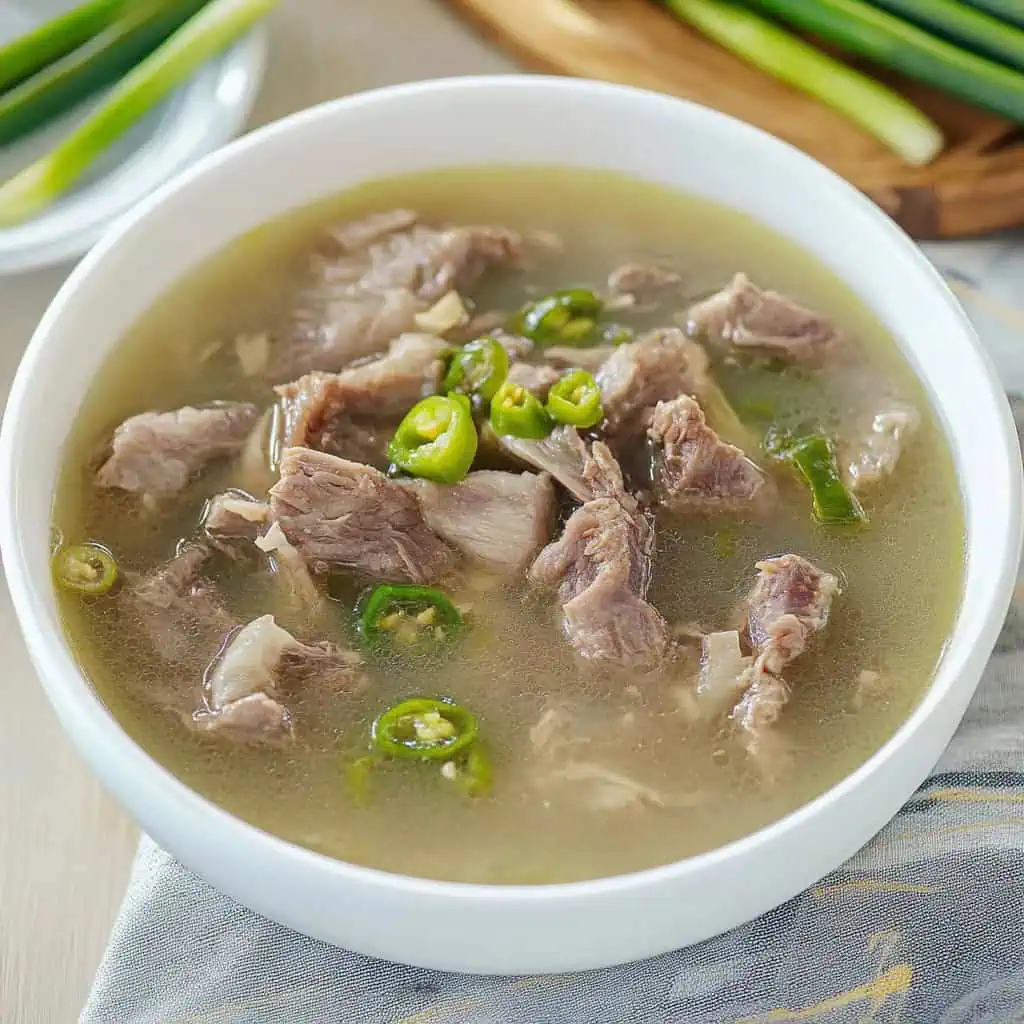
Why You'll Love This Recipe
- Authentic Filipino flavors with the perfect balance of sourness and savory notes
- Rich, gelatinous broth that's incredibly comforting and warming
- Known for its restorative properties - traditionally served to help with hangovers
- Can be prepared ahead and tastes even better the next day
- Impressive dish perfect for special occasions and family gatherings
Ingredients
This recipe uses specific ingredients that work together to create the authentic Filipino flavor profile of Sinampalukang Kambing. The goat meat provides a rich, hearty base that becomes wonderfully tender through slow cooking. Unripe tamarind delivers the signature sourness that cuts through the richness of the meat.
Ginger and onions add aromatic depth while helping eliminate any gamey taste. The finger chilies contribute a gentle heat that balances the sour notes. Fish sauce enhances the umami quality of the broth, and green onions add a fresh finish.
The initial vinegar marinade isn't just for flavor, it's crucial for removing the strong smell that many associate with goat meat, making this traditional dish approachable even for those new to cooking with kambing.

- 3 pounds goat meat (traditional: head and feet "up and down"; modern: shoulder or leg meat cut into 2-inch pieces)
- 2 cups white vinegar
- 1 tablespoon salt
- 2 pandan leaves (optional, for reducing gamey smell)
- 1 large onion, quartered
- 2 thumbs ginger, crushed
- 2 tablespoons fish sauce
- 1 pound unripe tamarind
- 5 finger chilies
- 1 bunch green onions
- Salt to taste
- 8-10 cups water
Equipment
- Large heavy-bottomed pot - Essential for slow cooking the meat until perfectly tender while maintaining even heat distribution.
- Fine-mesh strainer - Used to extract the tamarind juice while removing seeds and pulp for a smooth broth.
- Sharp knife - Necessary for properly preparing the meat and vegetables.
- Large mixing bowl - For marinating the meat to remove gamey flavors.
- Wooden spoon - Allows for gentle stirring without scratching your cooking pot.
- Mortar and pestle - Helps release essential oils from ginger and spices for more intense flavor.
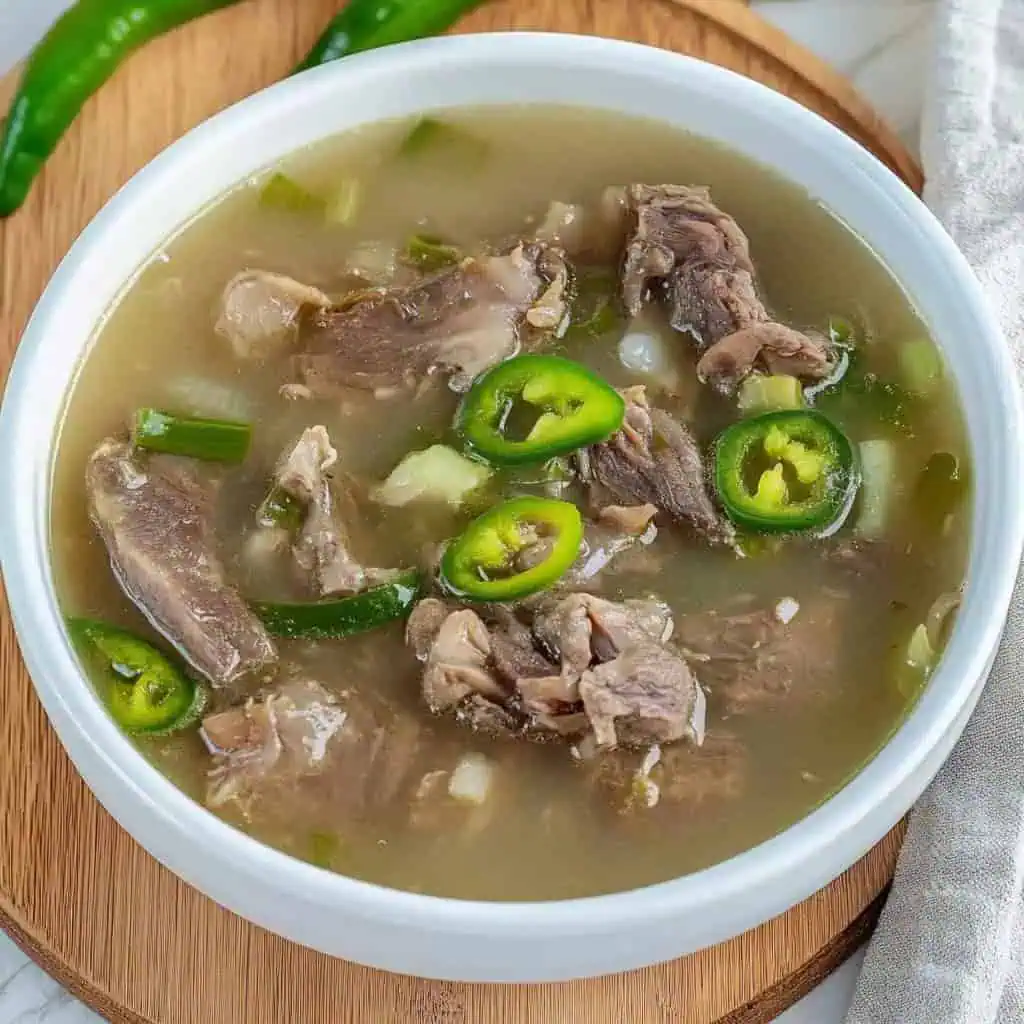
How To Make
- In a large bowl, combine the goat meat with vinegar and salt. Let it marinate in the refrigerator for 1 hour to remove the gamey taste. After marinating, rinse the meat thoroughly with clean water and drain well.
- Fill a large pot with enough water to cover the meat and bring to a boil over medium-high heat. Add the marinated goat meat and boil for 7-10 minutes until you see scum rising to the surface. Drain the meat in a colander and rinse both the meat and pot with clean water.
- Put the clean pot back on the stove over medium heat. Return the cleaned meat and add 6 cups of fresh water. Bring to a boil while skimming off any scum that rises. Once the broth is clear, add the quartered onion, crushed ginger, and fish sauce.
- Lower the heat, cover the pot, and simmer for about 1½ to 2 hours, or until the meat becomes tender but still firm. Remove and discard the ginger pieces.
- While the meat is cooking, prepare the tamarind. Wash the unripe tamarind and place in a separate pot with 2 cups of water. Bring to a boil and cook until the tamarind becomes soft and the skins begin to burst. Mash the tamarind with a fork.
- Strain the tamarind mixture through a fine-mesh strainer set over a bowl. Keep mashing with a fork, adding some cooking liquid back to get all the juice out. Throw away the seeds and skins, then pour the tamarind juice into the pot with the meat.
- Add the finger chilies and cook for 4-5 minutes. Taste the soup and add salt as needed. Add the chopped green onions and cook for just 1 minute more.
- Serve your soup steaming hot in bowls with rice on the side. If you like, serve with a small dish of fish sauce and calamansi for extra flavor.

Tips from Lola's Kitchen
- Choose young goat meat: Meat from goats less than 1 year old will yield more tender results.
- Proper marination is key: Don't rush the vinegar soak as it's essential for removing the gamey flavor (langsa).
- Double-boiling technique: The initial boiling and rinsing step creates a cleaner, clearer broth.
- Add aromatics: For deeper flavor, add lemongrass stalks (tanglad) during the simmering process.
- Serve piping hot: This soup should be served very hot to fully appreciate its complex flavors.
- Control the sourness: The longer you boil the tamarind, the more sour your broth will become - adjust to your preference.
- Prepare in advance: For best flavor development, consider making this dish a day ahead.
Substitutions
- Tamarind: Use 2 tablespoons of tamarind powder or 3 tablespoons of tamarind paste if fresh unripe tamarind is unavailable.
- Fish sauce: Replace with salt or soy sauce to taste, though the flavor profile will be slightly different.
- Fresh chilies: Substitute with dried chilies or chili flakes (start with 1-2 teaspoons).
- Green onions: Leeks or Chinese chives work well as alternatives.
- Goat meat: While traditional, you can use beef short ribs or lamb shoulder for a similar texture.
- Pandan leaves: If unavailable, add a few bay leaves and lemongrass for aroma.
Troubleshooting
- Meat too tough? Continue cooking on low heat until tender, adding more water if needed. Young goat meat typically takes 1.5-2 hours, while older meat may need up to 3 hours.
- Soup too sour? Balance with a pinch of sugar or more water to dilute the tamarind flavor.
- Not sour enough? Add more tamarind juice, a squeeze of calamansi, or a teaspoon of tamarind powder.
- Broth too cloudy? Ensure thorough skimming during the initial boiling process. For clearer broth, strain through cheesecloth.
- Too spicy? Remove some or all chilies before serving, or add a small amount of coconut milk to temper the heat.
- Broth too thin? Simmer uncovered for 15-20 minutes to reduce and concentrate flavors.
Storage & Reheating
- Refrigerator: Store in an airtight container for up to 3 days. The flavors will continue to develop, making it even more delicious.
- Freezer: Freeze in portion-sized containers for up to 2 months. Thaw overnight in the refrigerator before reheating.
- Reheating on stovetop: Heat slowly over medium heat until bubbling, adding a splash of water if the broth has thickened too much.
- Reheating in microwave: Use 2-3 minute intervals at medium power, stirring between cycles to ensure even heating.
- Freshening up: Add freshly chopped green onions when reheating to brighten the flavor.
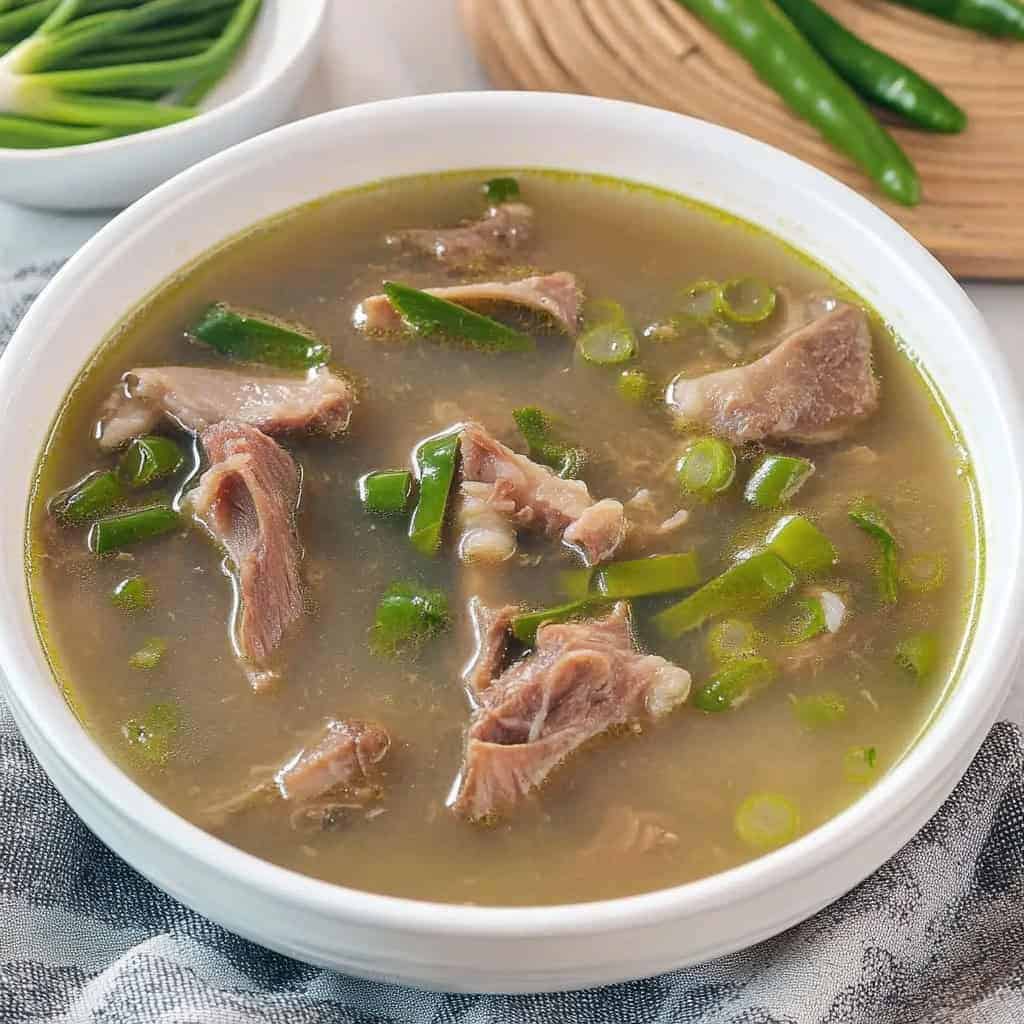
FAQ
What does "Sinampalukang Kambing" mean?
The name comes from "sampalok" (tamarind) and "kambing" (goat), literally meaning goat cooked with tamarind.
Why is it sometimes called "Up and Down"?
The traditional recipe uses both the goat's head (up) and feet (down), creating a gelatinous broth rich in collagen.
How do I know when the meat is properly cooked?
The meat should be tender enough to easily pull apart with a fork but still holding its shape. The collagen-rich parts should feel slightly gelatinous.
Can I make this in a pressure cooker or Instant Pot?
Yes, after the initial boiling and cleaning steps, pressure cook on high for 35-40 minutes with a natural release for tender meat.
Is this dish always spicy?
No, the chilies can be adjusted or omitted completely according to your heat preference.
Can I prepare this for a party in advance?
Yes, it actually tastes better when made a day ahead as the flavors have time to meld. Reheat gently before serving.
What's the best way to eat Sinampalukang Kambing?
Traditionally served with steaming white rice and a side of patis-calamansi (fish sauce with citrus) dipping sauce.
How can I make a richer version?
For a more indulgent variation, add 1 cup of coconut milk during the last 15 minutes of cooking for Sinampalukang Kambing sa Gata.
Can I use other parts of the goat?
Yes, while traditional recipes use head and feet, any bone-in cuts work well. Shoulder, leg, and ribs are excellent choices for home cooking.
How do I know if my goat meat is fresh?
Fresh goat meat should be bright red with white fat. The meat should be firm and have a clean, not overly strong smell.
Related
Looking for other recipes like this? Try these:

Authentic Sinampalukang Kambing (Filipino Sour Goat Soup)
Equipment
- Large heavy-bottomed pot (kaldero) for slow cooking the meat to tenderness
- Fine-mesh strainer (salaan) for extracting tamarind juice
- Sharp knife (kutsilyo) for preparing meat and vegetables
- Large mixing bowl for marinating meat
- Wooden spoon (sandok) for stirring without scratching the pot
- Mortar and pestle (dikdikan) for crushing ginger and spices
Ingredients
For the Meat Preparation
- 3 pounds goat meat kambing
- Traditional: head and feet up and down
- Modern: shoulder or leg meat cut into 2-inch pieces
- 2 cups white vinegar suka
- 1 tablespoon salt asin
- 2 pandan leaves optional, for reducing gamey smell
For the Soup Base
- 1 large onion sibuyas, quartered
- 2 thumbs ginger luya, crushed
- 2 tablespoons fish sauce patis
- 1 pound unripe tamarind sampalok
- 5 finger chilies siling haba
- 1 bunch green onions sibuyas dahon
- Salt to taste
- 8-10 cups water
Instructions
- In a large bowl, combine the goat meat with vinegar and salt. Let it marinate in the refrigerator for 1 hour to remove the gamey taste. After marinating, rinse the meat thoroughly with clean water and drain well.
- Fill a large pot with enough water to cover the meat and bring to a boil over medium-high heat. Add the marinated goat meat and boil for 7-10 minutes until you see scum rising to the surface. Drain the meat in a colander and rinse both the meat and pot with clean water.
- Put the clean pot back on the stove over medium heat. Return the cleaned meat and add 6 cups of fresh water. Bring to a boil while skimming off any scum that rises. Once the broth is clear, add the quartered onion, crushed ginger, and fish sauce.
- Lower the heat, cover the pot, and simmer for about 1½ to 2 hours, or until the meat becomes tender but still firm. Remove and discard the ginger pieces.
- While the meat is cooking, prepare the tamarind. Wash the unripe tamarind and place in a separate pot with 2 cups of water. Bring to a boil and cook until the tamarind becomes soft and the skins begin to burst. Mash the tamarind with a fork.
- Strain the tamarind mixture through a fine-mesh strainer set over a bowl. Keep mashing with a fork, adding some cooking liquid back to get all the juice out. Throw away the seeds and skins, then pour the tamarind juice into the pot with the meat.
- Add the finger chilies and cook for 4-5 minutes. Taste the soup and add salt as needed. Add the chopped green onions and cook for just 1 minute more.
- Serve your soup steaming hot in bowls with rice on the side. If you like, serve with a small dish of fish sauce and calamansi for extra flavor.
Tips from Lola's Kitchen
- Choose younger goat meat (less than 1 year old) for more tender results
- The key to removing gamey flavor (langsa) is proper marination
- Don't skip the initial boiling and rinsing step - it's crucial for a clean-tasting soup
- For extra flavor, add lemongrass (tanglad) during simmering
- The soup should be served very hot to appreciate its full flavor
Nutrition
The Story Behind Sinampalukang Kambing
The history of Sinampalukang Kambing weaves a fascinating tale through the culinary heritage of the Philippines, particularly in the Ilocos region where resourceful cooking has always been an art form. This hearty goat soup, born from the Ilocano tradition of maximizing every part of the animal, showcases the ingenuity of Filipino ancestors who learned to transform humble ingredients into extraordinary dishes. Known affectionately as "Up and Down" because it traditionally uses both the goat's head (up) and feet (down), this dish represents the Filipino value of avoiding food waste while creating something delicious.
In the northern provinces of the Philippines, where goat-raising has been a common practice for generations, Sinampalukang Kambing emerged as more than just a meal – it became a celebrated cure for hangovers and a staple at social gatherings. The abundant presence of tamarind trees in the region naturally led to its incorporation into local cuisine, with the unripe fruits lending their distinct sourness to various dishes. This particular combination of goat meat and young tamarind created a unique flavor profile that has been passed down through generations of Filipino families.
Today, Sinampalukang Kambing holds a special place in Filipino cuisine, especially during festivities and special occasions. While the traditional recipe calls for specific parts of the goat, modern adaptations often use meatier cuts to appeal to contemporary tastes. However, the essence of the dish – its sour-savory broth, tender meat, and comforting warmth – remains unchanged. Whether served as pulutan (appetizer) alongside ice-cold beer or as a warming family meal during rainy season, this dish continues to tell the story of Filipino culinary creativity and resourcefulness.
What makes this recipe particularly special is its role in preserving cultural heritage. As young Filipinos increasingly embrace global cuisine, dishes like Sinampalukang Kambing serve as a delicious reminder of our culinary roots. The careful preparation methods, from marinating the meat to extracting tamarind's sourness, reflect time-honored techniques that have been perfected over generations. Each bowl not only offers nourishment but also connects diners to the rich tapestry of Filipino food culture, where every dish tells a story of family, tradition, and innovation.
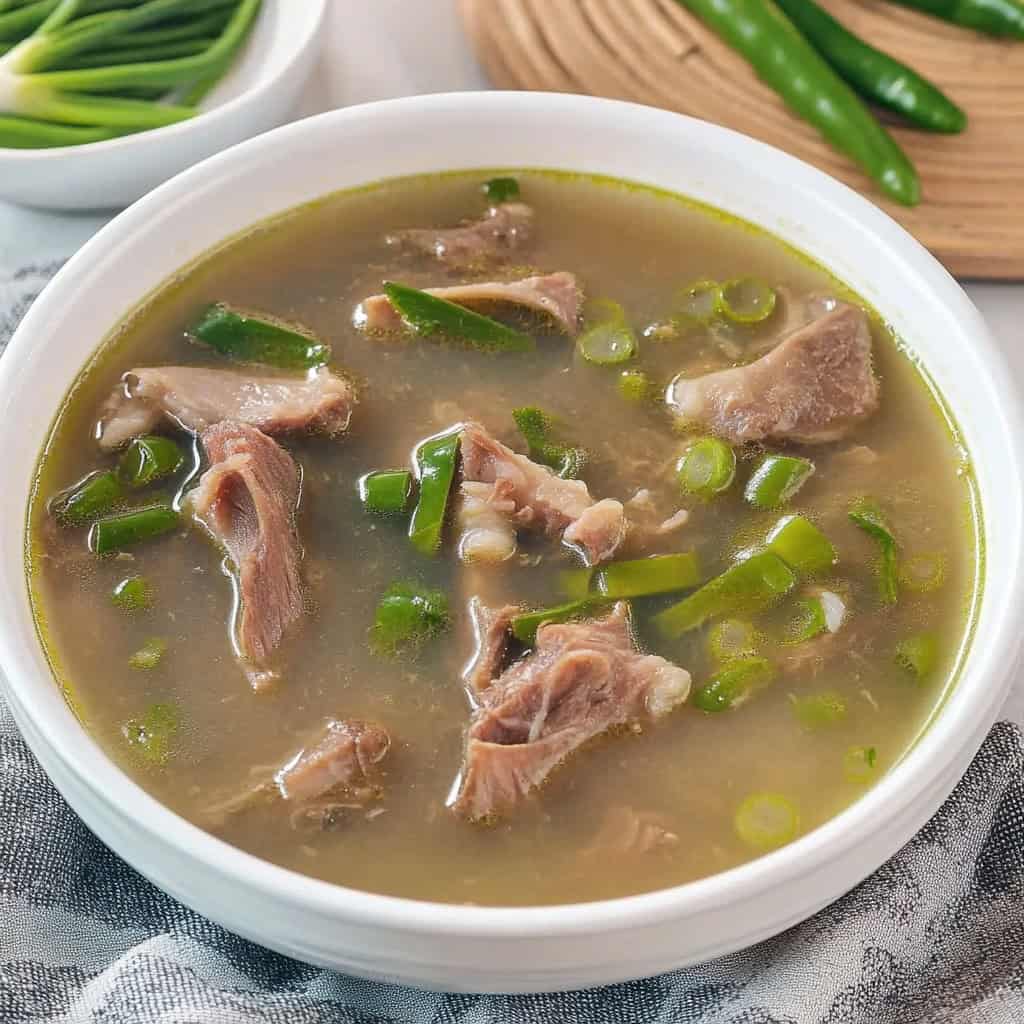


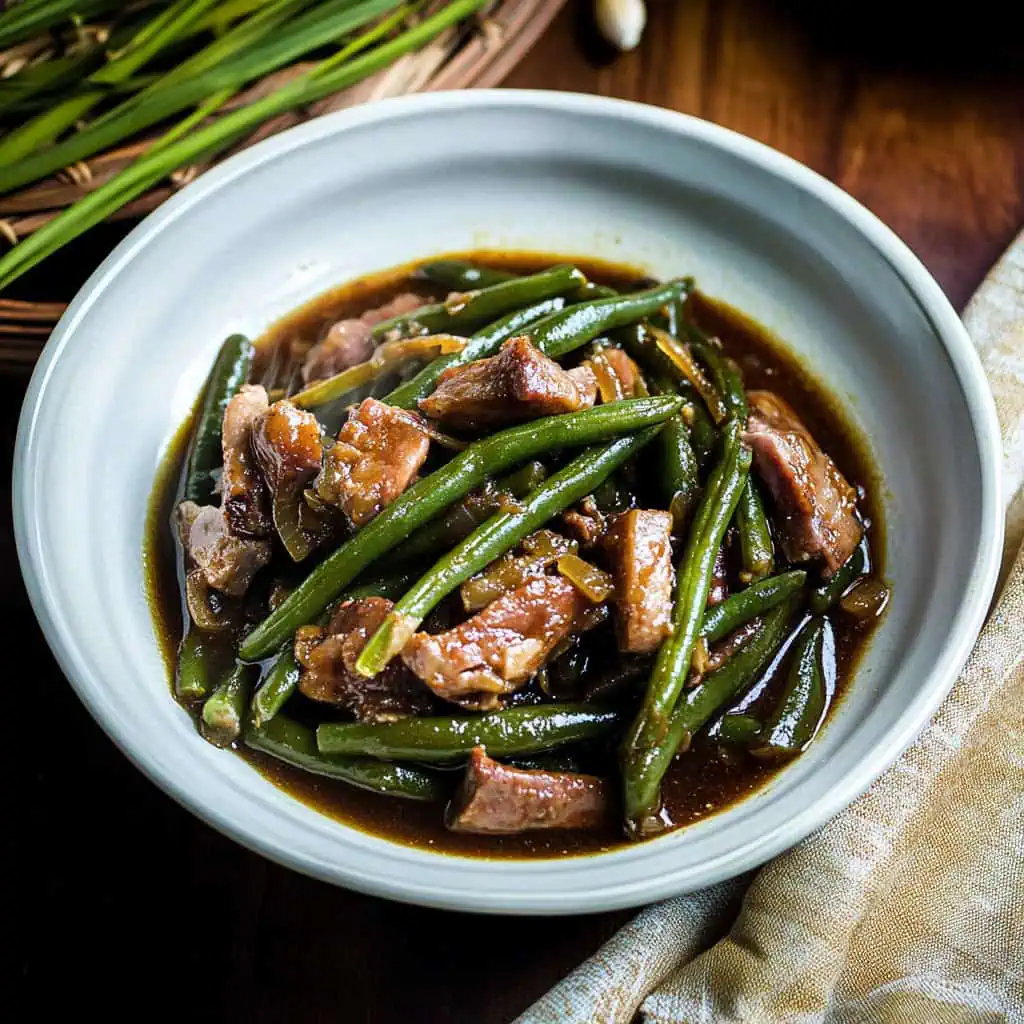

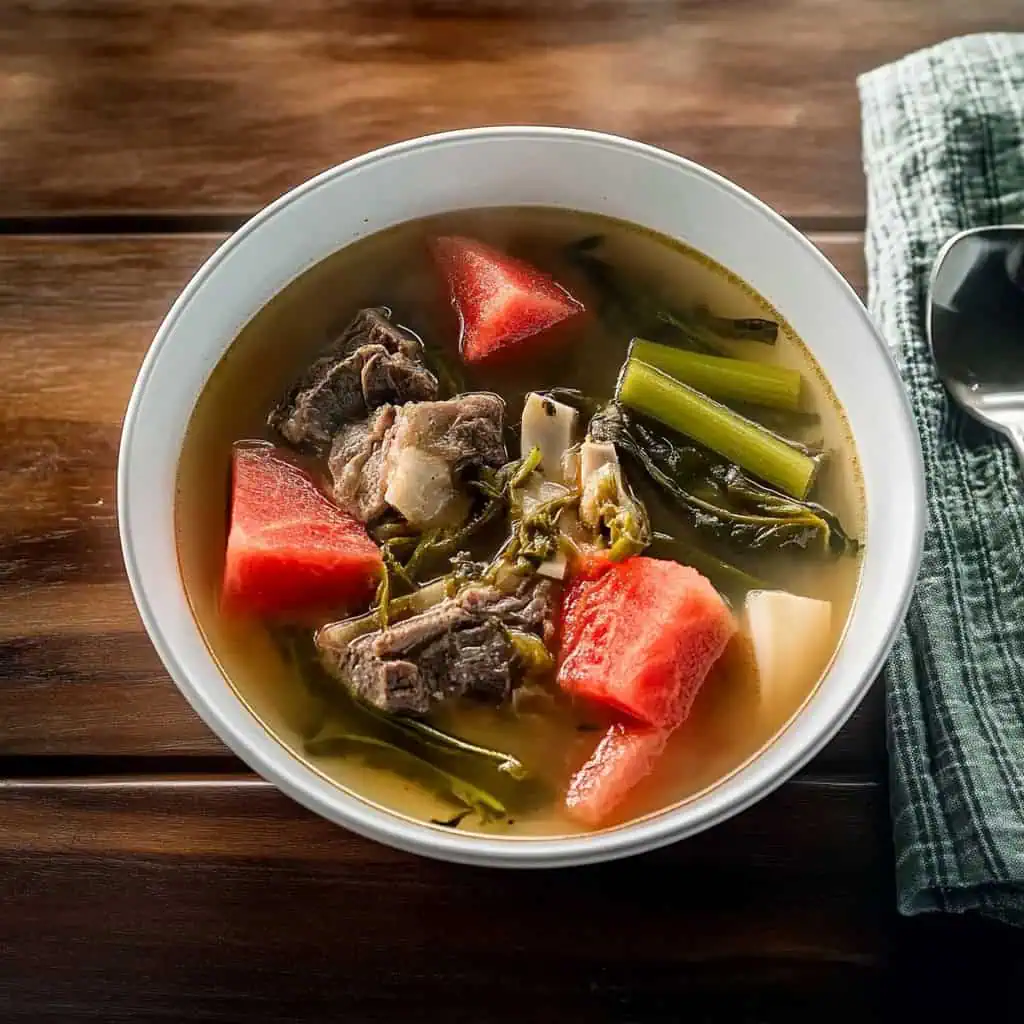




Comments
No Comments